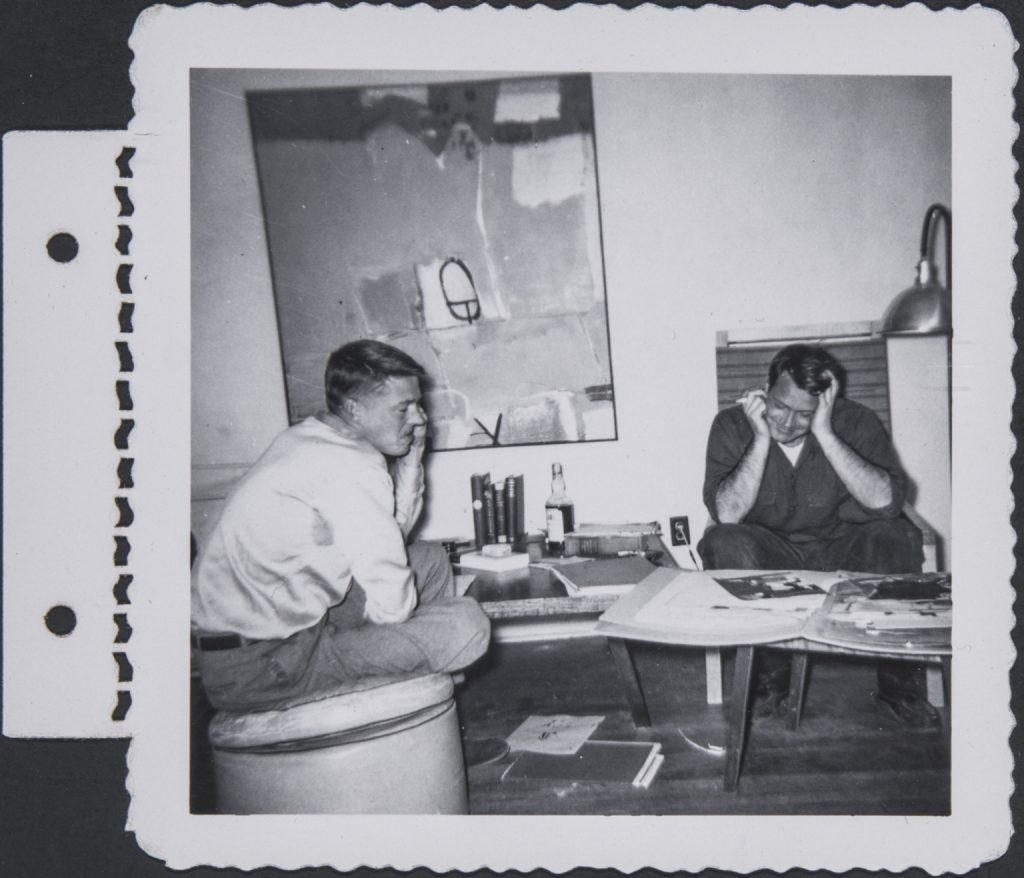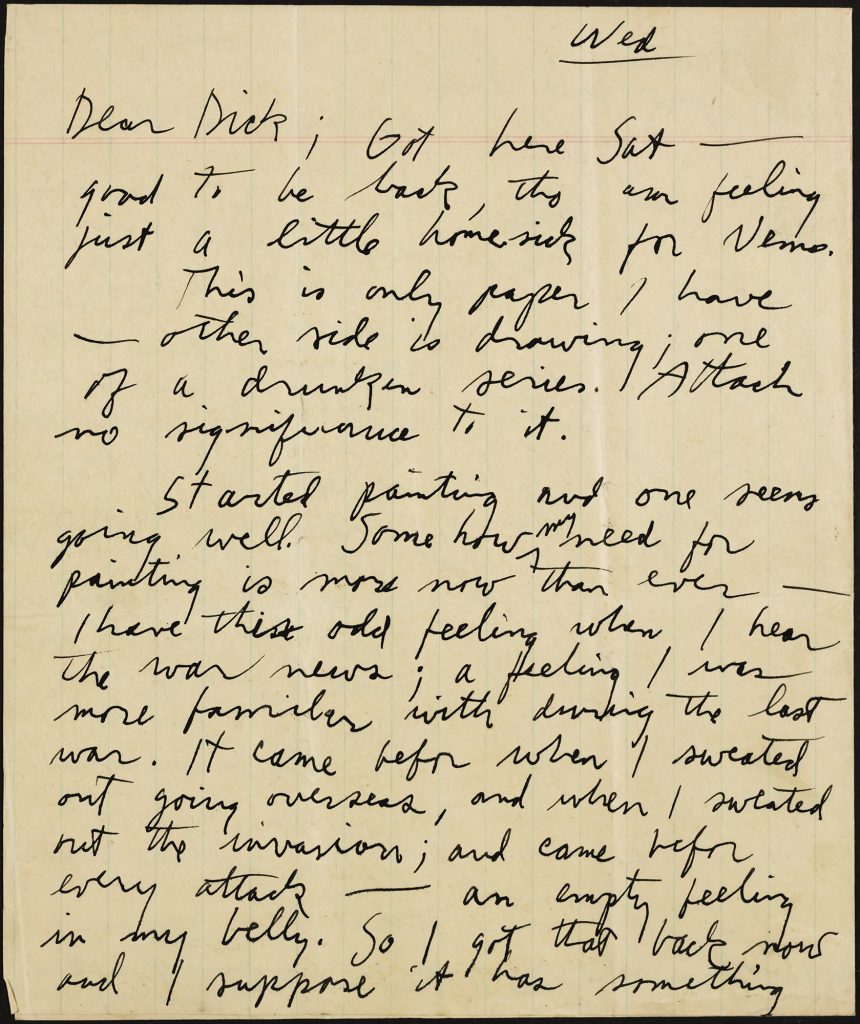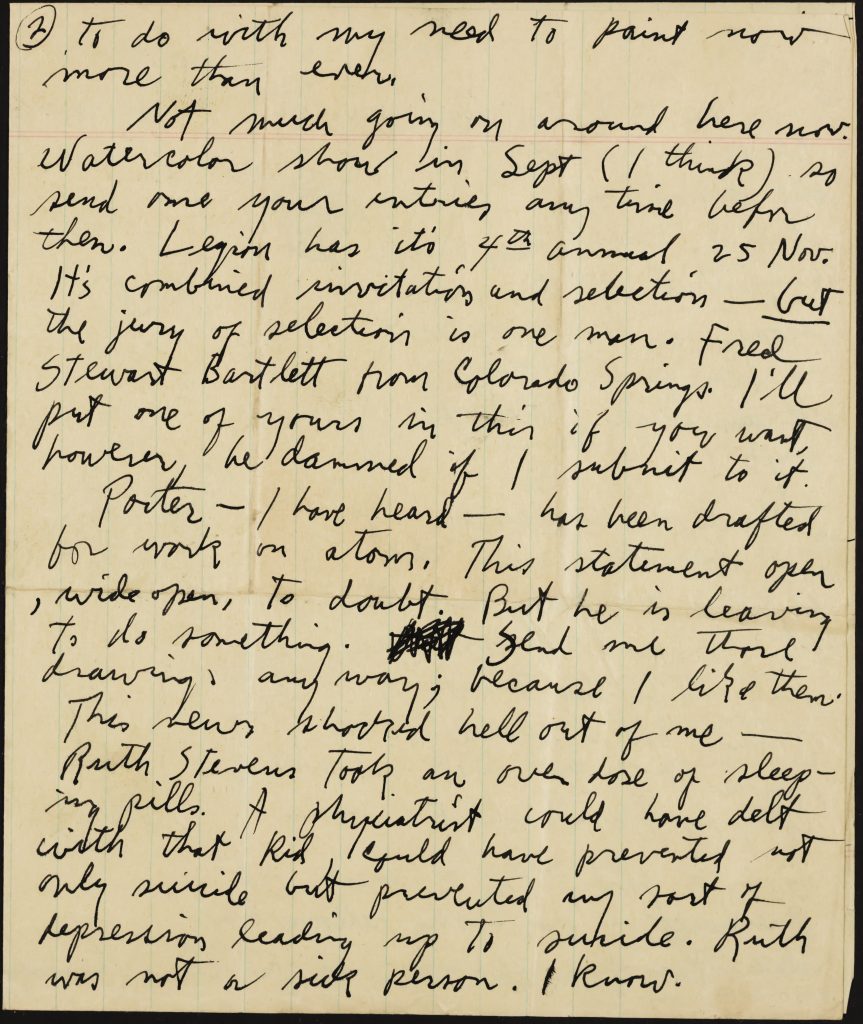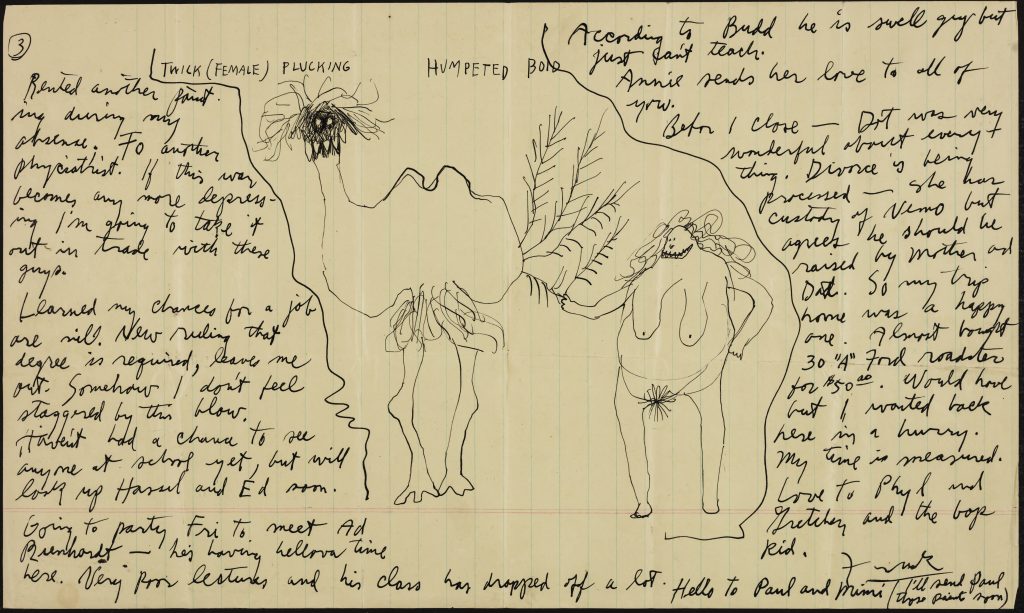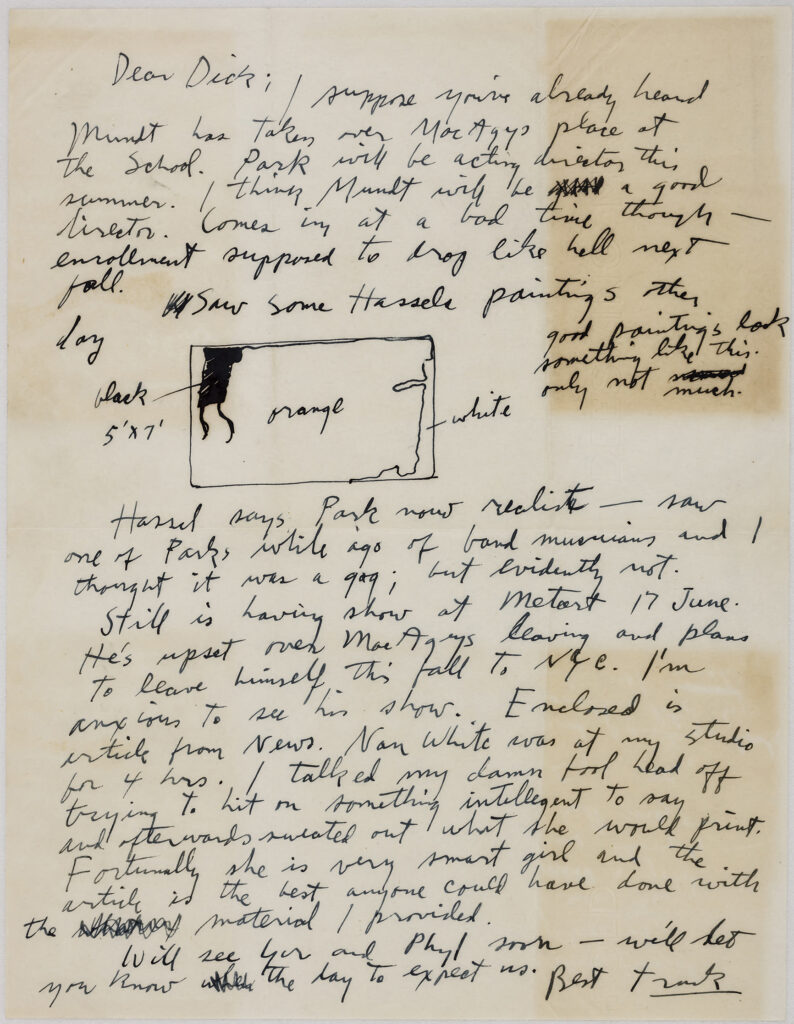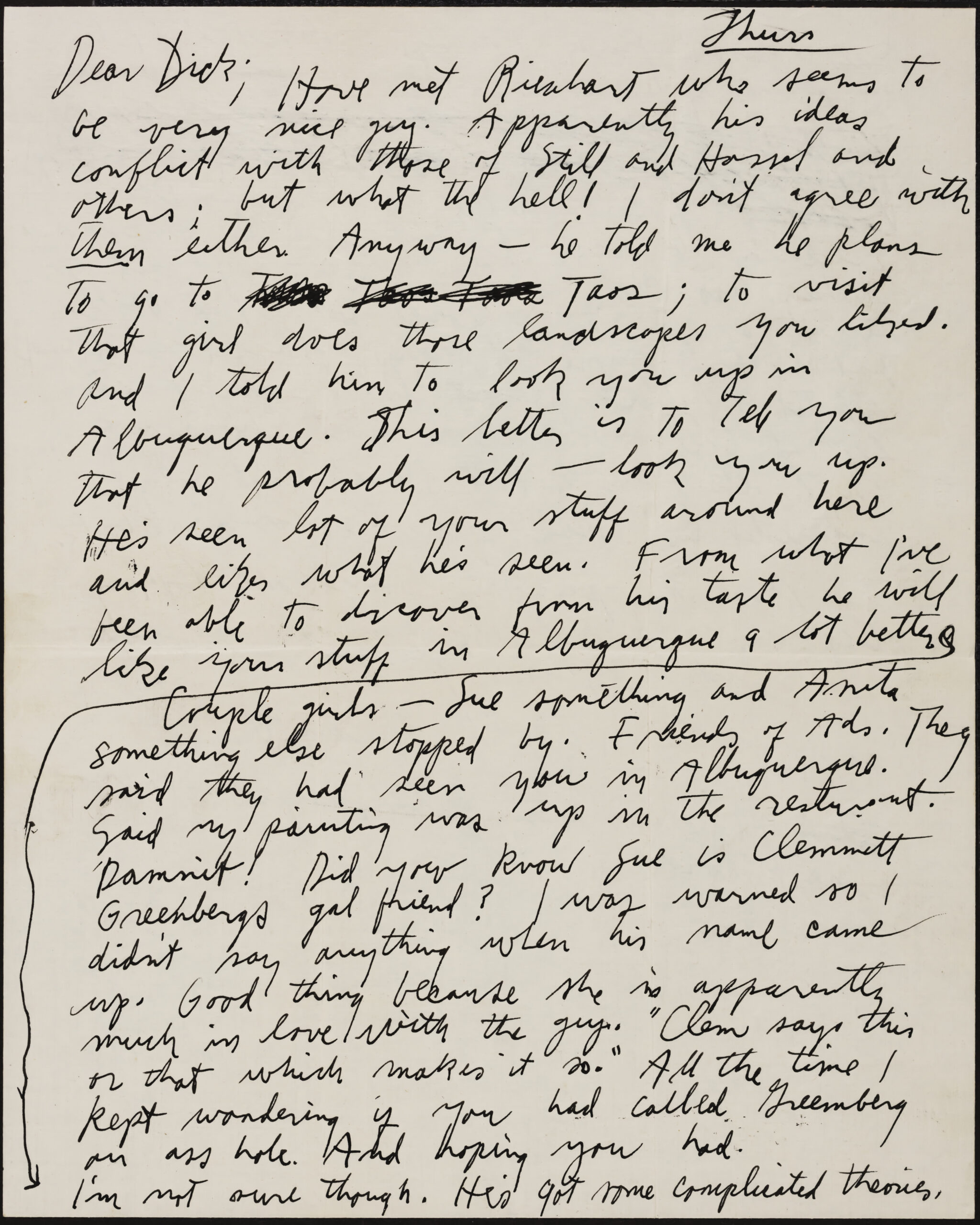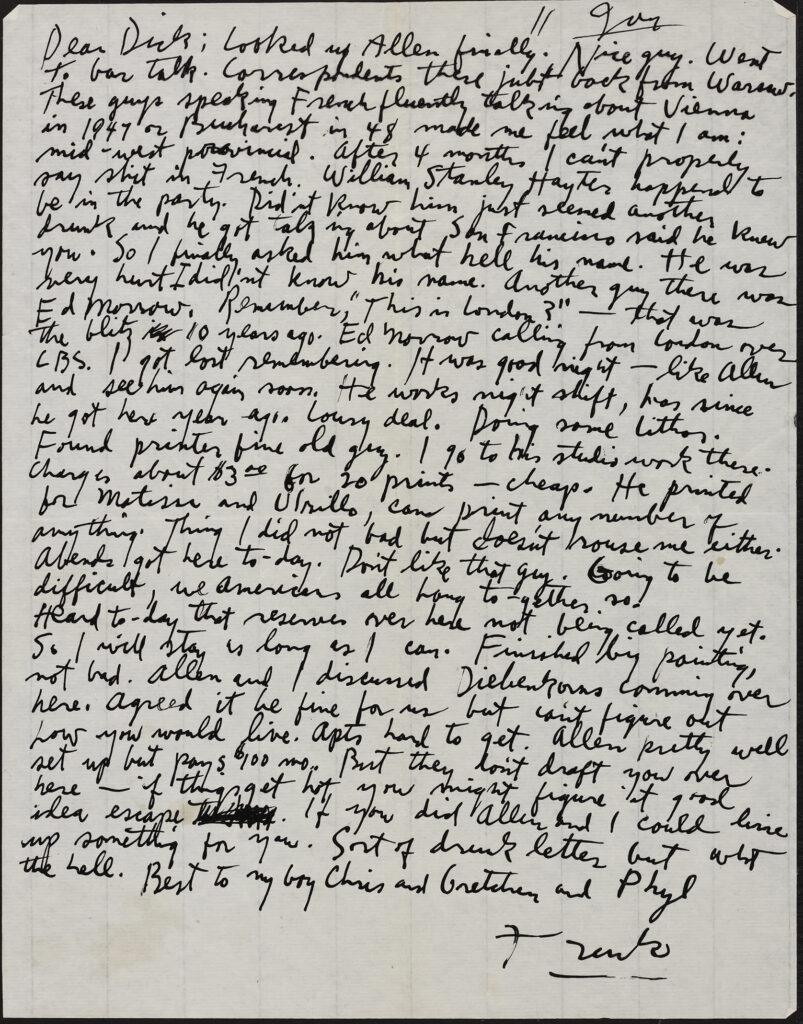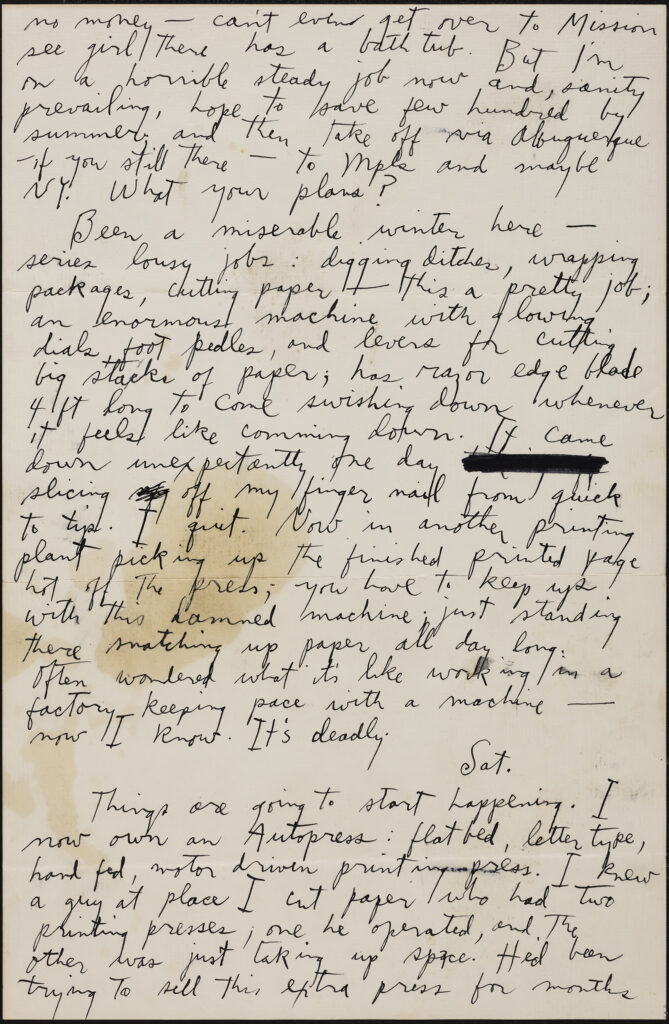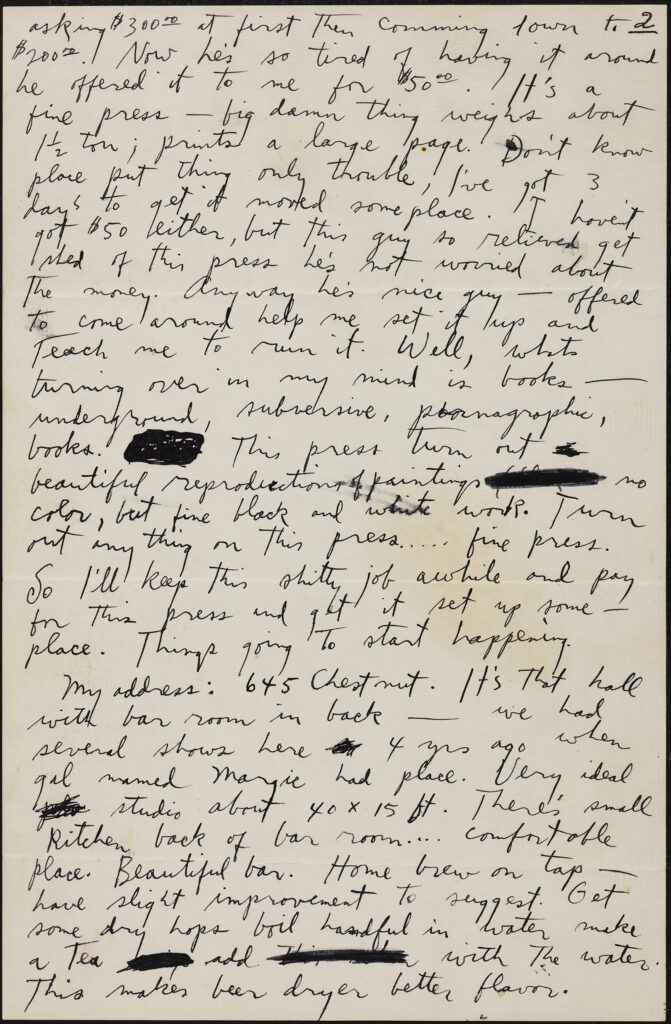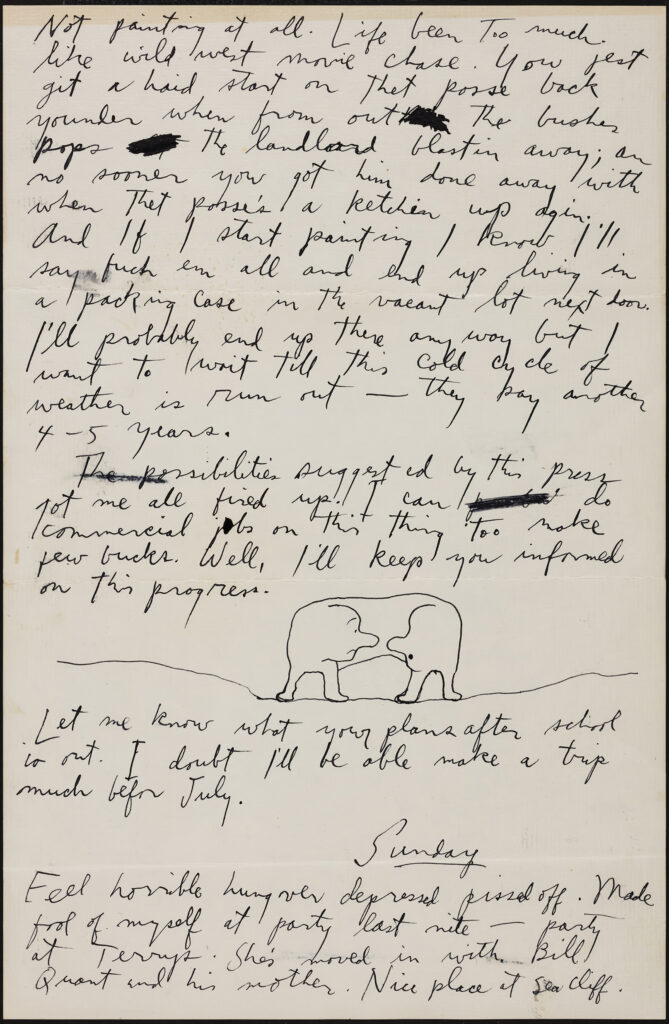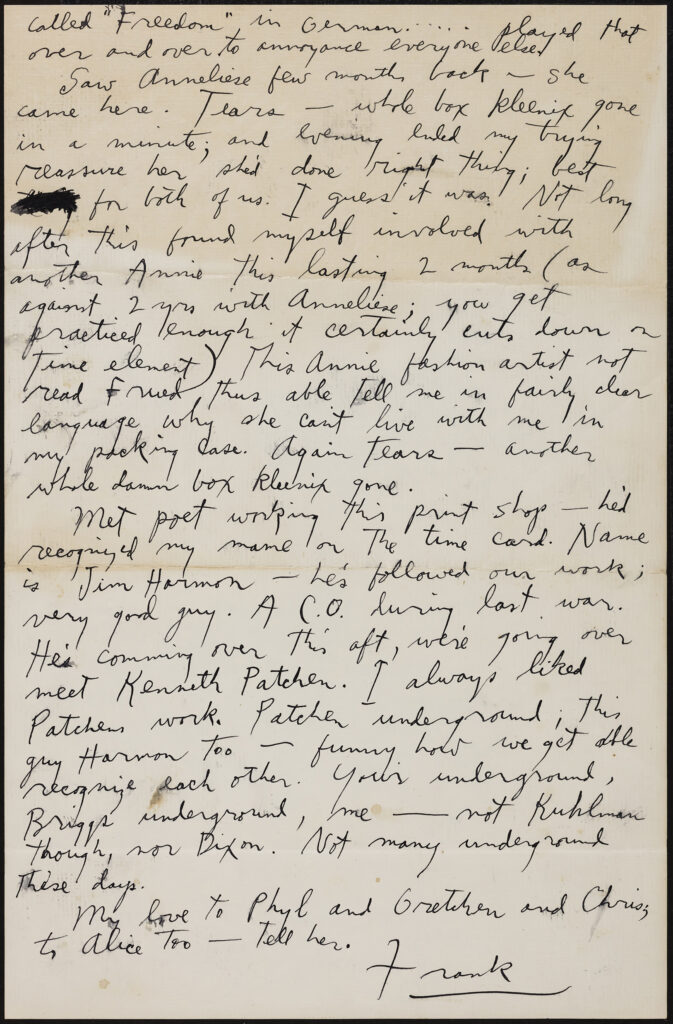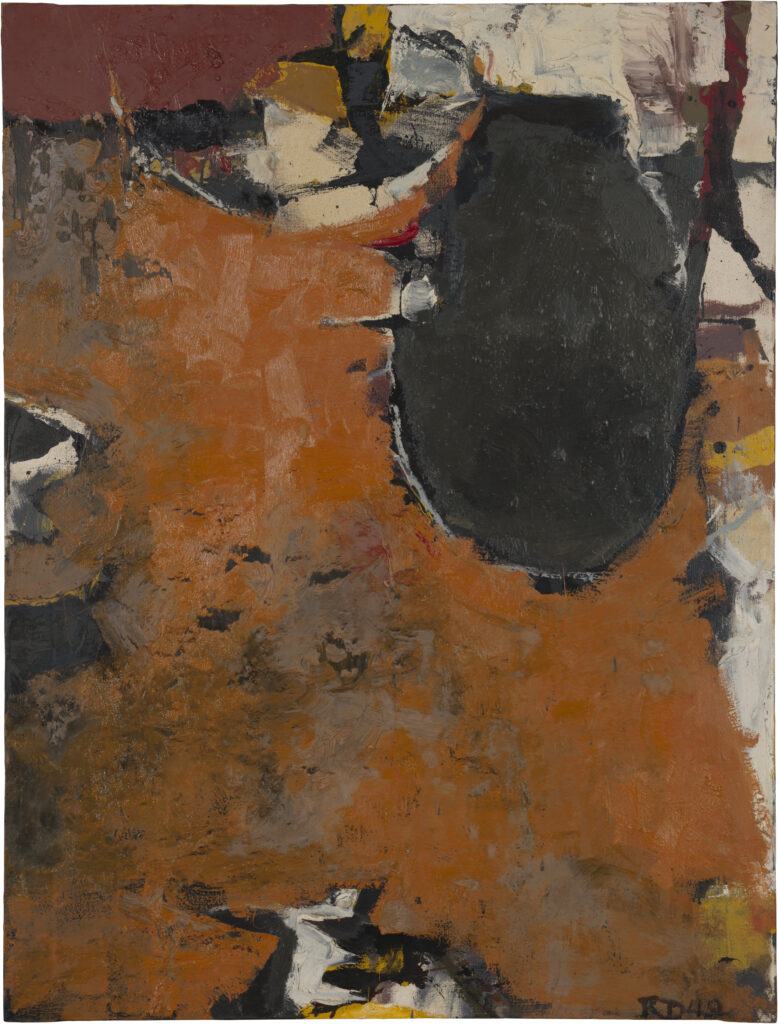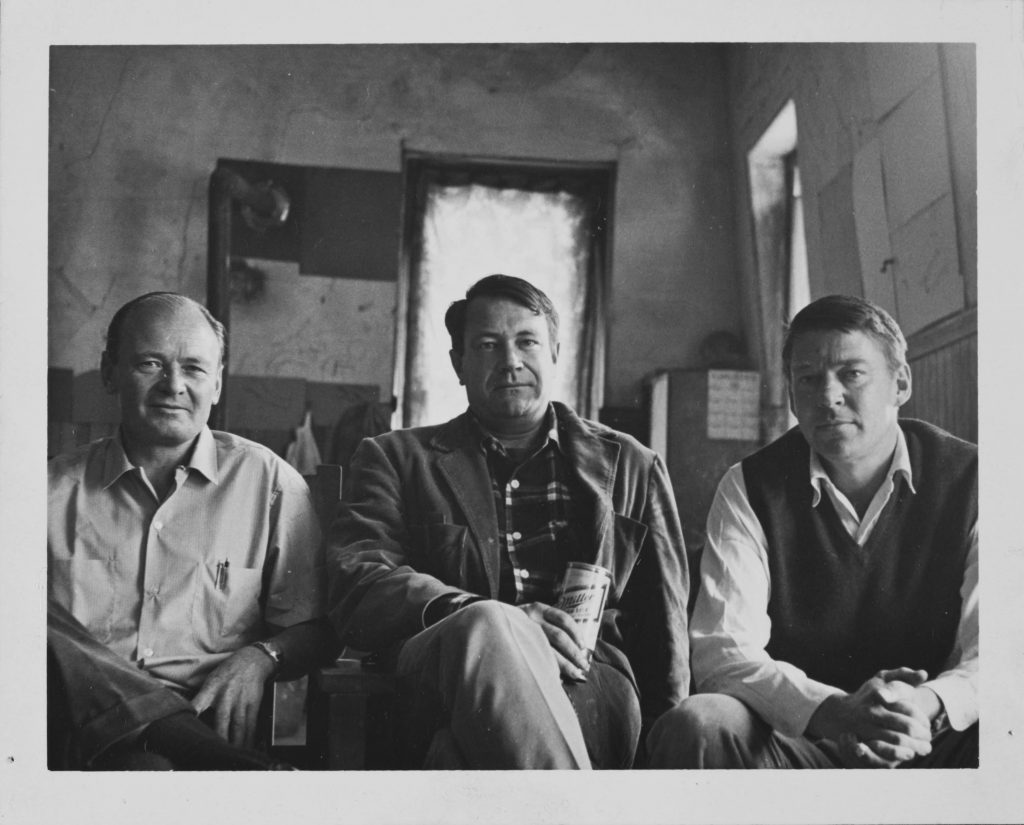Friendship at a Distance: Richard Diebenkorn and Frank Lobdell, 1950–1953
By Jacquelyn Northcutt
November 18, 2021
As a student of art history at the University of California, Berkeley, I was given the opportunity to intern at the Richard Diebenkorn Foundation this summer. Throughout the 8-week program, I was completely immersed in the life and career of Richard Diebenkorn. With access to the Richard Diebenkorn Foundation Archives, I started to form a picture of Diebenkorn’s life that extends beyond the academic, and have become familiar with his surroundings and relationships, including their immediate impacts on his work.
In the post-World War II era, the San Francisco Bay Area became a hub for Abstract Expressionists, mirroring the artistic trend in New York.1 As a student and then instructor at the California School of Fine Arts (CSFA) in San Francisco, Richard Diebenkorn was surrounded by a web of artists, including Elmer Bischoff, John Hultberg, Frank Lobdell, David Park, and Hassel Smith. During these early, formative years of Diebenkorn’s career, his connection to this community of artists gave him opportunities of professional and artistic growth and exposed him to like-minded peers who guided and shaped his progression.
Diebenkorn developed a particularly strong friendship with Frank Lobdell (1921–2013). The two exchanged dozens of letters over the course of their lives, many of which Diebenkorn kept and are now preserved in the Richard Diebenkorn Foundation Archives. The majority of these letters are from the years 1950 to 1952, when Richard Diebenkorn was completing a master’s degree at the University of New Mexico in Albuquerque. During this time, Lobdell was living and working mostly in San Francisco and partially in Paris, utilizing the GI Bill to study at the Academie de Chaumiere. Given the physical separation of the artists, their correspondence was a way to keep in touch about their personal and professional lives. While we only have access to the letters sent from Lobdell to Diebenkorn, they offer us insight into their particular way of communicating with one another and the dynamics of their relationship. Lobdell informs Diebenkorn with information about upcoming exhibitions and descriptions of his latest paintings, including quotes or newspaper articles about these new works. Lobdell also seems to rely on Diebenkorn as a friend. He writes with a tone that reflects their familiarity and personal relationship, often writing to seek emotional support from Diebenkorn.
In August 1950 at the beginning of the Korean War, Lobdell shares his anxiety about being drafted after his service in World War II, saying, “Somehow my need for painting is more now than ever – I have this odd feeling when I hear the war news; a feeling I was more familiar with during the last war. It came before when I sweated out going overseas, and when I sweated out the invasion; and came before every attack – an empty feeling in my belly. So I got that back now and I suppose it has something to do with my need to paint now more than ever.”2 This kind of raw vulnerability is indicative of the close confidence they shared and reliance on one another for support.
In another tender moment, after Diebebkorn helped his friend sell a work in August 1950, Lobdell discusses the business details while also digging into his difficulties painting and his anxieties around the Korean War, saying, “If I am very lucky I will be in Paris within two weeks… If I don’t get out now it’ll be Korea uncomfortably soon… Thing is I can’t paint knowing, as I do; that to-morrow is my last day. I know it won’t be much better in Paris but I will face that when I come to it.”3 As he predicted, Lobdell’s time in Paris did come with its own challenges and concerns. However, even as he shares his homesickness and frustrations with his friend, Lobdell puts art in the forefront: “Hans Arp will be there next week. Maybe Miro soon. Be interesting to hear what Arp, Miro, maybe Braque, my gods of 10 years ago; have to say. I have a feeling they will like what we do (for I will subject your print to this criticism) but that feeling may come from my believing in it as hard as I do. Your print, by the way, hangs to-gether beautifully. Have it on the wall, see it every day, and like it more each time.”4
In these letters, Lobdell also updates Diebenkorn on their mutual friends and often refers to other artists in familiar tones, omitting parts of their names or using affectionate nicknames. Elmer Bischoff, John Hultberg, and David Park are referred to as Elmer, Johnny, and Park. In describing the recent work of these other artists, Lobdell often accompanies the descriptions with his own opinions and musings, sometimes including misspelled or abbreviated words. In a letter from June 1950, Lobdell mentions some of Park’s most recent works: “Hassel [Smith] says Park now realist – saw one of Parks while ago of band musicians and I thought it was a gag; but evidently not.”5 This same letter also includes a sketch of what Lobdell deems to be the best of Hassel Smith’s most recent paintings, which is simultaneously humorous and informative for Diebenkorn.
Further, Lobdell advocated on Diebenkorn’s behalf within the San Francisco Bay Area community. There are numerous examples of him offering Diebenkorn opportunities to sell his work. Lobdell informed Diebenkorn about upcoming exhibitions and offered to submit work on his behalf. For example, Diebenkorn’s inclusion in the Seventy-First Annual Painting and Sculpture of the San Francisco Art Association became possible when Lobdell remembered he owned two of Diebenkorn’s works and submitted them for consideration. In a letter from early April 1952 he informs Diebenkorn of this, saying, “While unpacking going thru my treasures found your painting I own and another good one (orange, black, white) and 2 of Hultbergs painted about same time (1948) and some of mine of ‘48. I put these in the oil annual. You were only one accepted.”6
Diebenkorn’s visibility as an artist through his relationship with Lobdell grew beyond the Bay Area as well, such as with an introduction to New York artist Ad Reinhardt. This connection can be tracked directly through Lobdell’s letters. In a letter from August 10, 1950, Lobdell writes, “Have met Reinhart who seems to be very nice guy… and I told him to look you up in Albuquerque… He’s seen lot of your stuff around here and likes what he’s seen. From what I’ve been able to discover from his taste he will like your stuff in Albuquerque a lot better.”7 Less than a month later on September 8, 1950, Reinhardt sent Diebenkorn a letter with an offer for his works to be featured in a book on modern art.8
After a short teaching stint in Urbana, Illinois, the Diebenkorn family returned to the San Francisco Bay Area in 1953 and settled in Berkeley. This choice gave Diebenkorn’s wife the opportunity to study at the University of California, Berkeley, while also allowing Diebenkorn to quickly immerse himself again in the local arts community. He reconnected with his close friend and mentor David Park and joined weekly drawing sessions from a live model with Park, Elmer Bischoff, Paul Wonner, and William Theophilus Brown.9 Diebenkorn and Lobdell also enjoyed spending time together with their spouses, often sharing meals at the Diebenkorns’ home in Berkeley. After dinner, they sometimes picked up paper and a mark making tool of choice, drawing late into the night.10
Through the letters exchanged between Lobdell and Diebenkorn, a better understanding of their personalities and wit can be garnered, while also exposing aspects of the greater Bay Area artistic community from the 1940s and 1950s. This element of my internship offered a humanization of otherwise entirely historical figures, allowing me to gain a deeper knowledge and appreciation of the contexts behind their work.
1. Caroline A. Jones, Bay Area Figurative Art: 1950-1965 (Berkeley, CA: Univ. of California Pr., 1990).
2. Frank Lobdell, letter to Richard Diebenkorn, August 1 1950, Richard Diebenkorn Foundation Archives.
3. Frank Lobdell, letter to Richard Diebenkorn, August 15, 1950, Richard Diebenkorn Foundation Archives.
4. Frank Lobdell, letter to Richard Diebenkorn, October [16?], 1950, Richard Diebenkorn Foundation Archives.
5. Frank Lobdell, letter to Richard Diebenkorn, June 1, 1950, Richard Diebenkorn Foundation Archives.
6. Richard Diebenkorn’s Untitled #6 (1948) and Painting II (1949) were the works Lobdell submitted on Diebenkorn’s behalf. Frank Lobdell, letter to Richard Diebenkorn, April 20, 1952, Richard Diebenkorn Foundation Archives.
7. Frank Lobdell, letter to Richard Diebenkorn, August 10, 1950, Richard Diebenkorn Foundation Archives.
8. This book was called Modern Artists in America (1951), edited by Robert Motherwell and Ad Reinhardt.
9. Lobdell was sometimes invited to these weekly drawing sessions, but did not officially join the group until after David Park’s death in 1960. Daisy M. Holman, “Chronology,” in Richard Diebenkorn: The Catalogue Raisonné, Vol. 1, ed. Jane Livingston and Andrea Liguori (New Haven, CT: Yale University Press, 2016), 159.
10. Diane Roby and Anthony Torres, “Illustrated Chronology,” Frank Lobdell: The Art of Making and Meaning (San Francisco, CA: Hudson Hills Press, 2003), 321.
References:
Holman, Daisy Murray. “Chronology.” In Richard Diebenkorn: The Catalogue Raisonné, Vol. 1, edited by Jane Livingston and Andrea Liguori, 142-190. New Haven, CT: Yale University Press. 2016.
Nash, Steven. “Figuring Space: Representational Work, 1955-1967.” Essay. In Richard Diebenkorn: The Catalogue Raisonné, Vol. 1, edited by Jane Livingston and Andrea Liguori, 61-87. New Haven, CT: Yale University Press. 2016.
Jones, Caroline A. Bay Area Figurative Art: 1950-1965. Berkeley, CA: University of California Press, 1990.
Burgard, Timothy Anglin, et al. Frank Lobdell: The Art of Making and Meaning. San Francisco, CA: Hudson Hills Press, 2003.
